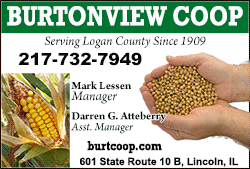|
Spanish flu impacts in Logan
County still felt 100 years later
 Send a link to a friend
Send a link to a friend
 [April 19, 2019] [April 19, 2019]
LINCOLN
Bill Donath’s presentation Monday evening at the monthly meeting of
the Logan County Genealogical and Historical Society was about one
of the most horrifying events of the early twentieth century. No, it
was not World War I.
The Spanish flu epidemic that appeared at the close of the Great War
took more lives than the war itself, perhaps as many as ten times
the causalities of the war.
Bill is currently doing research on the Spanish flu epidemic and its
effects on Lincoln and Logan County. His previous research includes
the Civil War and World War I with a similar focus on what they
meant to Lincoln and Logan County.
The Spanish flu was a worldwide epidemic that left no part of the
globe untouched. It arrived in Logan County on a specific date,
October 5, 1918. We know this because of the records from Logan
County that Donath researched. There it is, the first record of the
flu in Logan County followed by forty pages of nothing but illnesses
and deaths from the flu.
To say it ravaged Logan County is an understatement.
While the flu itself was a serious and debilitating illness, the
secondary infections that people got because of their weakened
immune systems tended to be the ones that resulted in death. It is
sort of a perfect storm of an epidemic that the 1918 Spanish flu was
so bad. “Pneumonia had been increasing in the world in the years
before the flu,” said Donath. It turned out to be the main secondary
illness that leads to the majority of deaths.
Because of the war, large groups of people were forced to congregate
in military camps, and the flu had an easy population to infect. The
spread was rapid. Between the first record of a flu case on October
5, 1918, and the end of the year, two-thousand cases occurred in
Logan County resulting in one-hundred deaths. It was extremely
contagious.

“In Lincoln and Logan County, some of the trends of the flu were
especially tragic,” said Bill Donath. Young women who had just given
birth were especially vulnerable. Doctors and nurses were not
immune. In 1918, doctors were called away from Logan County to treat
the troops in military camps around the state, leaving their
patients at home with no medical care.
Whole families were taken ill. One Mount Pulaski family of twelve
with two parents and ten children, were all infected. Both parents
died. St. Clara’s and Deaconess, the two hospitals in Lincoln at the
time were full with flu victims. Records show that deaths occurred
in homes, but the rest of the family was too sick to remove the
bodies. The horror was everywhere.
The flu was a painful and debilitating illness. It usually took two
weeks of hell before a person succumbed to the illness or secondary
pneumonia. There was no treatment at the time for either. It was
said that death was an angel given the horrendous toll the illness
took on a person. Folk remedies were tried to no avail. Whiskey and
leaving a person outdoors during the illness were two common
treatments. People were desperate.
“Schools were closed numerous times in Logan County to try to stem
the spread,” said Bill Donath. When cases subsided, school was
started again only to see the shadow of the flu reoccur as the close
confines of a one room schoolhouse brought children together to pass
on the virus to each other and their families at home.
“One offshoot of the illness and burgeoning death toll was the
effect on the Lincoln Casket Factory. It was operating twenty-four,
seven,” said Donath.

[to top of second column] |

The Spanish flu epidemic even has an effect on present time. Bill
Donath researched the death records of Logan County extensively. “Sometimes I
had to get up from my research and walk away. It gave me an odd feeling, and was
very disturbing going over these records,” he said.
And then, as quickly as it appeared in October of 1918, it was gone in 1920.
Theories abound about its origin, none with any hard facts. Today, flu vaccines
are available before the start of flu season for everyone to forestall an
epidemic. Modern science has created a barrier to the flu and other contagious
illnesses. We just have to use it.

The Logan County Genealogical and Historical Society meets on the third Monday
of the month at their research facility on Chicago Street in Lincoln at 6:30
p.m. They always have an interesting speaker and the public is invited to
attend.

001 Logan County historical researcher/speaker Bill Donath.

007 One of the tragic stories about a family devastated by the Spanish flu
epidemic that struck 1918 to 1920. This young mother was typical of the new moms
who were unusually susceptible to the flu.

008 Doctors and nurses were not immune to the ravages of the Spanish flu.

009 A poster encouraging correct behavior to prevent the spread of the flu.


010 One way to prevent the spread of the flu was to quarantine a family. Imagine
the feeling of being imprisoned in your home with a silent killer. In some cases
it was documented that people died in the home, but were not removed for burial
because family members were too sick to help.

011 A poster calling the public to help the war effort by preventing the spread
of the flu. It was said that ten people died of the flu for every soldier who
died during combat in World War I.
[Curtis Fox] |